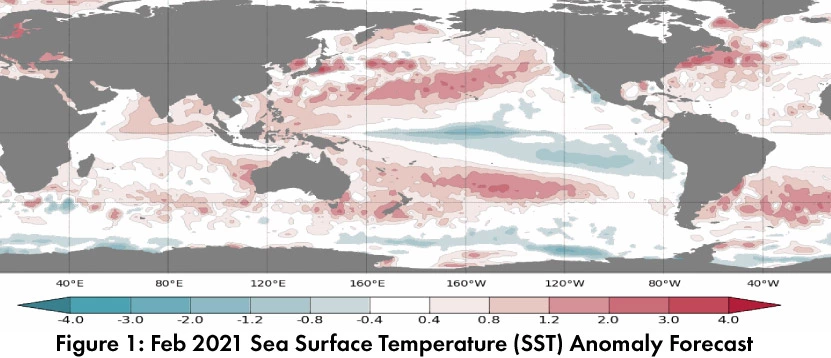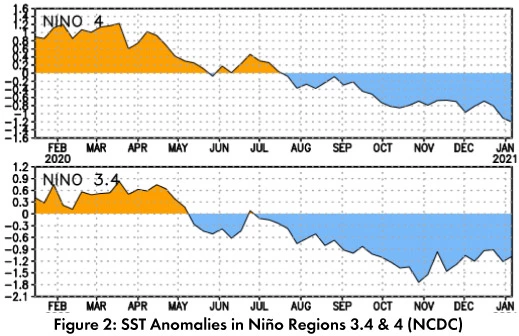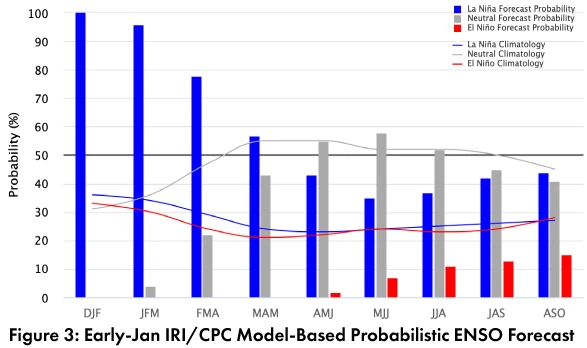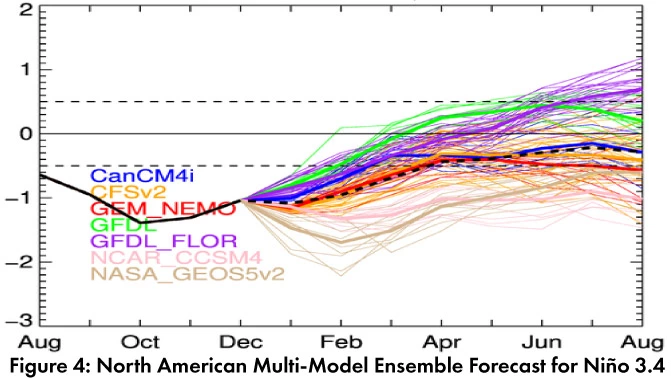Southwest Climate Outlook - El Niño Tracker - January 2021
Sea surface temperature (SST) forecasts for February 2021 call for below-normal conditions across the equatorial Pacific (Fig. 1), extending the trend of the last 4-5 months (Fig. 2). International climate outlooks generally see La Niña conditions persisting through winter 2020-2021 before returning to ENSO-neutral conditions over spring 2021.


Forecast Roundup: On Jan 12, the Japanese Meteorological Agency (JMA) maintained its observation of an ongoing La Niña event, and with a 50-percent chance of this event either continuing or a return to ENSO-neutral conditions. On Jan 14, the NOAA Climate Prediction Center (CPC) ENSO status was at La Niña Advisory. The CPC called for a 95-percent chance of La Niña continuing through March and a 55-percent chance of transition to neutral during late spring or early summer. On Jan 14, the International Research Institute (IRI) issued an ENSO Quick Look (Fig. 3), noting “the east-central Pacific is roughly 1.2 degrees C below average, and all key atmospheric variables are consistent with La Niña conditions”. On Jan 19, the Australian Bureau of Meteorology was at official La Niña status and noted, “La Niña is likely to have reached its peak with respect to sea surface temperature patterns in the eastern and central Pacific Ocean”, but that impacts are expected to persist into spring. The North American Multi-Model Ensemble (solid and dashed black line, Fig. 4) indicates moderate La Niña conditions are expected for the next few months, with a return towards ENSO-neutral conditions by late spring or early summer.


Summary: La Niña conditions are present and likely to remain in place through winter or early spring. The monthly and seasonal climate outlooks suggest drier than normal conditions over the same period, consistent with La Niña events in the U.S. Southwest. Drier than normal does not mean zero precipitation, however (for example, there is a large event forecast for the region at the time of this writing). Still, the likely outcome would be less frequent events and lower seasonal totals, consistent with long-term averages for La Niña winters.
Online Resources
- Figures 1 - Australian Bureau of Meteorology - bom.gov.au/climate/enso
- Figure 2 - NOAA - Climate Prediction Center - cpc.ncep.noaa.gov
- Figure 3 - International Research Institute for Climate and Society - iri.columbia.edu
- Figure 4 - NOAA - Climate Prediction Center - cpc.ncep.noaa.gov

